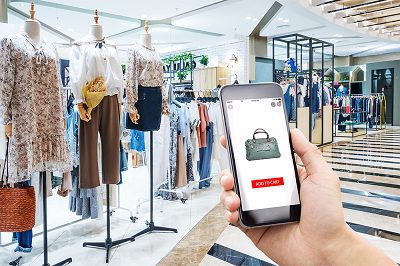Even as points of customer contact multiply, retailers are tasked with making the most of every interaction along the shopper journey. The 2018 Connected Consumer webinar series from Retail TouchPoints highlighted innovative solutions and strategies for maximizing each contact point with a retailers’ customer target groups. Following are brief recaps of the seven webinars in the #CCSeries, which are now available on-demand.
4 Email Marketing Strategies That Create Relevant Experiences
Greg Zakowicz, Senior Commerce Marketing Analyst at Oracle + Bronto, kicked off the Connected Consumer series with the webinar, titled: Increased Expectations Means Better Email Marketing: Are You Prepared?
Zakowicz shared four email marketing strategies designed to create relevant consumer experiences, along with real-world examples explaining how these strategies can be successful. The four strategies highlighted include:
- Welcome messaging;
- Browse recovery;
- Abandoned cart; and
- Product recommendations.
Product recommendations are one of the major drivers of relevant email experiences, but they also drive other important metrics, such as click rate and revenue per email (RPE). Zakowicz noted that retailers using product recommendations saw a 13% lift in click rate over those that didn’t, a 112% conversion rate boost and a 155% jump in RPE. Shoppers tend to like these recommendations, with 44% becoming repeat buyers after personalized experiences.
Managed Services Can Produce Significant CX Benefits
While it may not be as glamorous as launching a new mobile app or introducing virtual reality, having a streamlined process in place for in-store technology deployments is critical to controlling costs and avoiding customer service headaches.
“The complexity of an infrastructure technology solution in today’s world is really driving the need for seamless management,” said Diana Pace, Partner of Managed Services North America at Toshiba Global Commerce Solutions during the webinar, titled: When A Managed Services Approach Produces Better Consumer Experiences. “Technology projects are projects. They have a definite beginning and a definite ending, so you need to be able to scale those resources.”
Pace said that the first phase — the planning process — is the most important part of deployment, emphasizing “it’s the number one reason why projects succeed or fail.” Key strategies for planning include assigning resources, creating a staging process and installation schedules.
Key benefits of leveraging Managed Services to integrate retail tech solutions in stores include:
- Increased lane availability due to efficient processes and strong measurements of an experienced retail team;
- A 50% to 60% increase in efficiency when using a managed services team as opposed to in house specialists; and
- Accelerated time to value on a retail investment.
O’Neill Increases Site-Wide Conversion Rates 26% With Personalization
In the webinar, titled: Know What You Customers Want Before They Do, Nathan Liu, VP of Ecommerce/Digital at La Jolla Group, and Kurt Heinemann, CMO of Reflektion, discussed how retailers can leverage customers’ onsite shopping behavior with an enriched product catalog and AI to merchandise the most relevant products to each individual shopper in real time.
La Jolla was able to increase site-wide conversion rates 26% for one of its premier brands, O’Neill, when it deployed the Reflektion solution. Additionally, the brand saw a 62% boost in page views.
“Prior to Reflektion, there was very little personalization on the customer experience side for Oneill.com,” said Liu. “We added more merchandising zones on our home page and our shopping cart. We implemented a preview search on the site with personalized items and category recommendations. In addition, we worked with the Reflektion team to ensure that the experience is fluid on mobile as well.”
Heinemann identified three criteria retailers must abide by to optimize personalization:
- Identify customers as a segment of one and capture their shopping behavior, preferences and intent in individual profiles;
- Process data in real time to create a moment-to-moment engagement that responds to every new customer action; and
- Deliver individualized experiences consistently across all touch points.
Micro-Learning Gives The Wireless Experience A 73% Sales Boost
Abby Strother, Head of Development & Strategic Initiatives for The Wireless Experience (TWE), described how TWE instituted a mobile micro-learning training platform to boost sales while lowering turnover in the webinar, titled: Future-Proof Your Retail Frontline To Improve In-Store Experience.
Salespeople for TWE, an AT&T-authorized retailer of wireless and home automation solutions with more than 80 locations, faced challenges keeping up with fast-changing technology, communicating with highly informed consumers and absorbing training that came through traditional methods.
Knowing that associates had limited time for training and no desire to be pulled off the floor, Strother was attracted to micro-learning — small bits of knowledge directly tied to the performance or behavior desired — and the Axonify platform. Although the program is voluntary, by allowing employees to use their personal mobile devices TWE has seen a 91% participation rate.
“We’ve been able to decrease our voluntary staff turnover in the first 90 days by 38%,” Strother said. By correlating the use of the platform with products sold, TWE found that “those who have gone through the micro-learning [are] 73% more effective in selling,” she added.
Data Helps Retailers Meet Omnichannel Needs of Luxury Shoppers
Luxury retailers may not see the volume of online purchases that other merchants do, but that doesn’t mean their digital offerings don’t contribute to the shopper experience, according to the webinar, titled: Digital Transformation For Luxury And Specialty Retailers. Many shoppers either browse online before purchasing a product in-store, or visit a physical location and complete the sale through a web site, according to Jason Diaz, Pre-Sales Solution Architect for Retail at Hitachi Solutions.
Customers looking for luxury goods need as much information as possible, according to Philip R. Kennedy, Director of IT at Pandora Jewelers. Tracking shopper needs and wants and providing them to sales associates can ease the purchasing journey across all channels.
“Data is gold,” said Tim Henderson, East Director of Business Development for Advanced Analytics and IoT at Hitachi. “It’s the value that’s hidden inside our organizations, and now tools are available to uncover it.”
IoT Funding To Top $770 Billion In 2018
The digital revolution, including the Internet of Things (IoT), is altering the retail landscape as profoundly as malls did in the 1970s, according to Bryan Amaral, Founder, President and CEO of Clientricity. By utilizing the IoT, retailers can bring together people, commerce and data to create a true omnichannel experience, according to the webinar, titled: How Mobile Connected Commerce, Sensor Networks, And IoT Are Enabling Smarter Stores.
Retailers are already moving quickly to prepare for and adopt IoT technology:
- Approximately 50% of retailers already have adopted some kind of IoT technology, according to Gartner;
- Nearly 70% of retail decision-makers are ready to make the changes needed to prepare for IoT, according to Zebra; and
- IDC projects that funding for IoT projects is expected to reach $772.5 billion in 2018.
Attribute-Based Assortments Can Boost Revenue 3% To 20%
Retailers that use machine learning and predictive analytics tools to determine which product attributes lead customers to a buying decision can boost their revenues from 3% to 20%. The size of the revenue increase depends on the product category and how much variance exists within it, according to Kevin Stadler, President and CEO, 4R Systems. Stadler and Marsha Shapiro, SVP Product Management at 4R Systems, spoke at the webinar, titled: Optimizing Assortments By Focusing On Attribute-Based Demand Patterns.
To create an attribute-based decision tree that maps shopper behavior, retailers need to determine true demand for their products rather than relying predominantly on POS data. “If you only look at the POS, you don’t know if something didn’t sell because the person didn’t want it, or because it was in the back room or out of stock,” said Shapiro. “With true demand data, you can get a more accurate forecast.”
In addition to boosting existing sales, use of attribute-based demand can guide retailers toward which new products to add to their assortments. “You can look at where there’s high projected demand of attribute combinations that aren’t currently carried in your chain,” said Shapiro. “Then you can determine if filling in this ‘white space’ will lead to an increase in revenue, or simply cannibalize your existing sales.”
Catch up on any (or all) of the Connected Consumer series webinars, and share them with your colleagues!













